Outcome :
How to Login, Create User and Grant User in Oracle Database ?
Outcome :
Decision Making in C (if , if..else, Nested if, if-else-if )
Decision Making in C (if , if..else, Nested if, if-else-if )
Following are the decision-making statements available in C:if Statement
- if-else Statement
- Nested if Statement
- if-else-if Ladder
- switch Statement
- Conditional Operator
- Jump Statements:
- break
- continue
- goto
- return
Let’s discuss each of them one by one.
1. if in C
The if statement is the most simple decision-making statement. It is used to decide whether a certain statement or block of statements will be executed or not i.e if a certain condition is true then a block of statements is executed otherwise not.
Syntax of if Statement
Here, the condition after evaluation will be either true or false. C if statement accepts boolean values – if the value is true then it will execute the block of statements below it otherwise not. If we do not provide the curly braces ‘{‘ and ‘}’ after if(condition) then by default if statement will consider the first immediately below statement to be inside its block.
Flowchart of if Statement
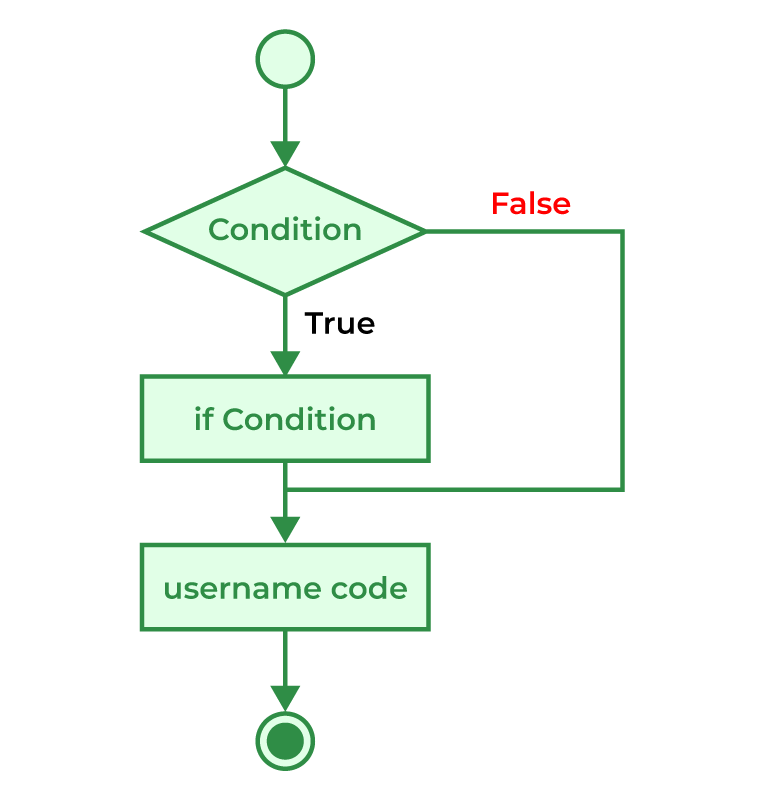
Output I am Not in if
As the condition present in the if statement is false. So, the block below the if statement is not executed.
2. if-else in C
The if statement alone tells us that if a condition is true it will execute a block of statements and if the condition is false it won’t. But what if we want to do something else when the condition is false? Here comes the C else statement. We can use the else statement with the if statement to execute a block of code when the condition is false. The if-else statement consists of two blocks, one for false expression and one for true expression.
// condition is false
Flowchart of if-else Statement
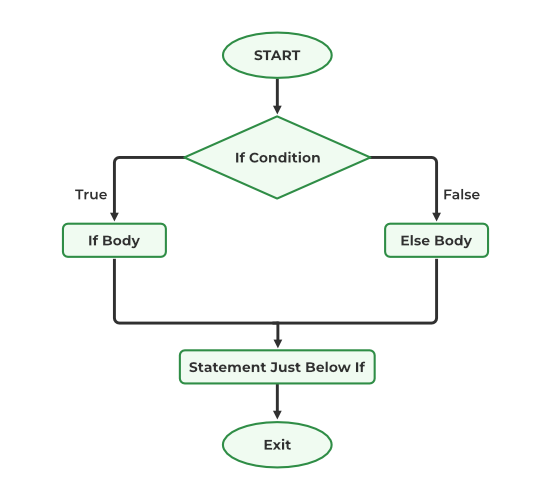
Example of if-else
// C program to illustrate If statement
Output i is greater than 15
The block of code following the else statement is executed as the condition present in the if statement is false.
3. Nested if-else in C
A nested if in C is an if statement that is the target of another if statement. Nested if statements mean an if statement inside another if statement. Yes, C allow us to nested if statements within if statements, i.e, we can place an if statement inside another if statement.
{
// statement 3
}
else
{
// Statement 4
}
}
The below flowchart helps in visualize the above syntax.

Example of Nested if-else
// C program to illustrate nested-if statement #include <stdio.h> int main() { int i = 10; if (i == 10) { // First if statement if (i < 15) printf( "i is smaller than 15\n"); // Nested - if statement // Will only be executed if statement above // is true if (i < 12) printf("i is smaller than 12 too\n"); else printf("i is greater than 15"); } else { if (i == 20) { // Nested - if statement // Will only be executed if statement above // is true if (i < 22) printf("i is smaller than 22 too\n"); else printf("i is greater than 25"); } } return 0; }
Outputi is smaller than 15 i is smaller than 12 too
4. if-else-if Ladder in C
The if else if statements are used when the user has to decide among multiple options. The C if statements are executed from the top down. As soon as one of the conditions controlling the if is true, the statement associated with that if is executed, and the rest of the C else-if ladder is bypassed. If none of the conditions is true, then the final else statement will be executed. if-else-if ladder is similar to the switch statement.
Syntax of if-else-if Ladderif (condition) statement; else if (condition) statement; . . else statement;
Flowchart of if-else-if Ladder
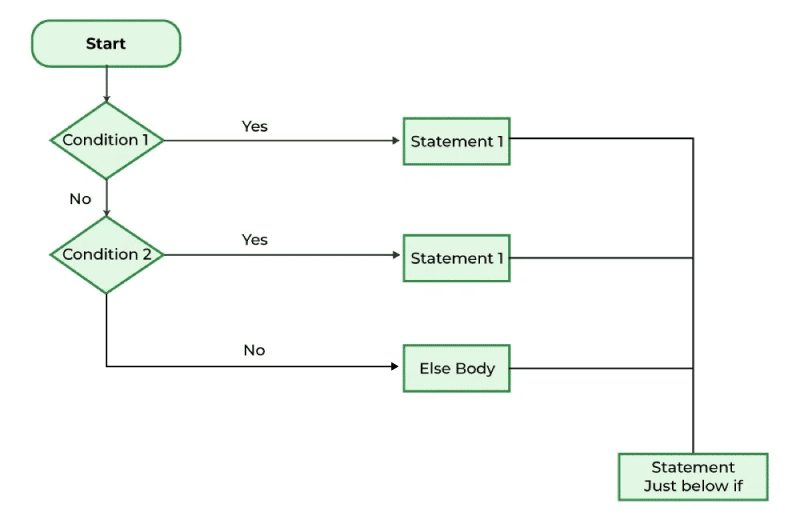
Flow Diagram of if-else-if
Example of if-else-if Ladder
C
// C program to illustrate nested-if statement #include <stdio.h> int main() { int i = 20; if (i == 10) printf("i is 10"); else if (i == 15) printf("i is 15"); else if (i == 20) printf("i is 20"); else printf("i is not present"); }
Outputi is 20
5. switch Statement in C
The switch case statement is an alternative to the if else if ladder that can be used to execute the conditional code based on the value of the variable specified in the switch statement. The switch block consists of cases to be executed based on the value of the switch variable.
Syntax of switchswitch (expression) { case value1: statements; case value2: statements; .... .... .... default: statements; }
Note: The switch expression should evaluate to either integer or character. It cannot evaluate any other data type.
Flowchart of switch
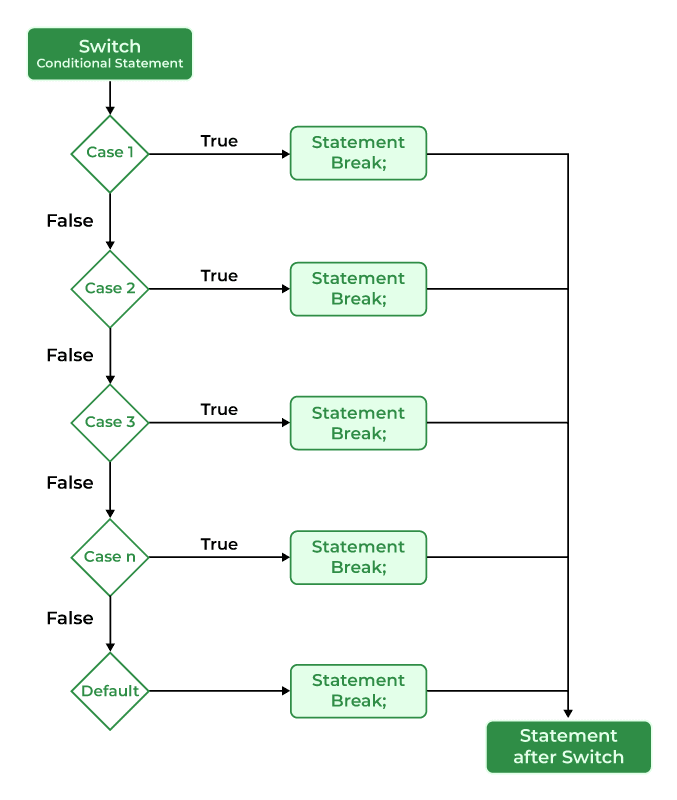
Flowchart of switch in C
Example of switch Statement
C
// C Program to illustrate the use of switch statement #include <stdio.h> int main() { // variable to be used in switch statement int var = 2; // declaring switch cases switch (var) { case 1: printf("Case 1 is executed"); break; case 2: printf("Case 2 is executed"); break; default: printf("Default Case is executed"); break; } return 0; }
OutputCase 2 is executed
6. Conditional Operator in C
The conditional operator is used to add conditional code in our program. It is similar to the if-else statement. It is also known as the ternary operator as it works on three operands.
Syntax of Conditional Operator(condition) ? [true_statements] : [false_statements];
Flowchart of Conditional Operator
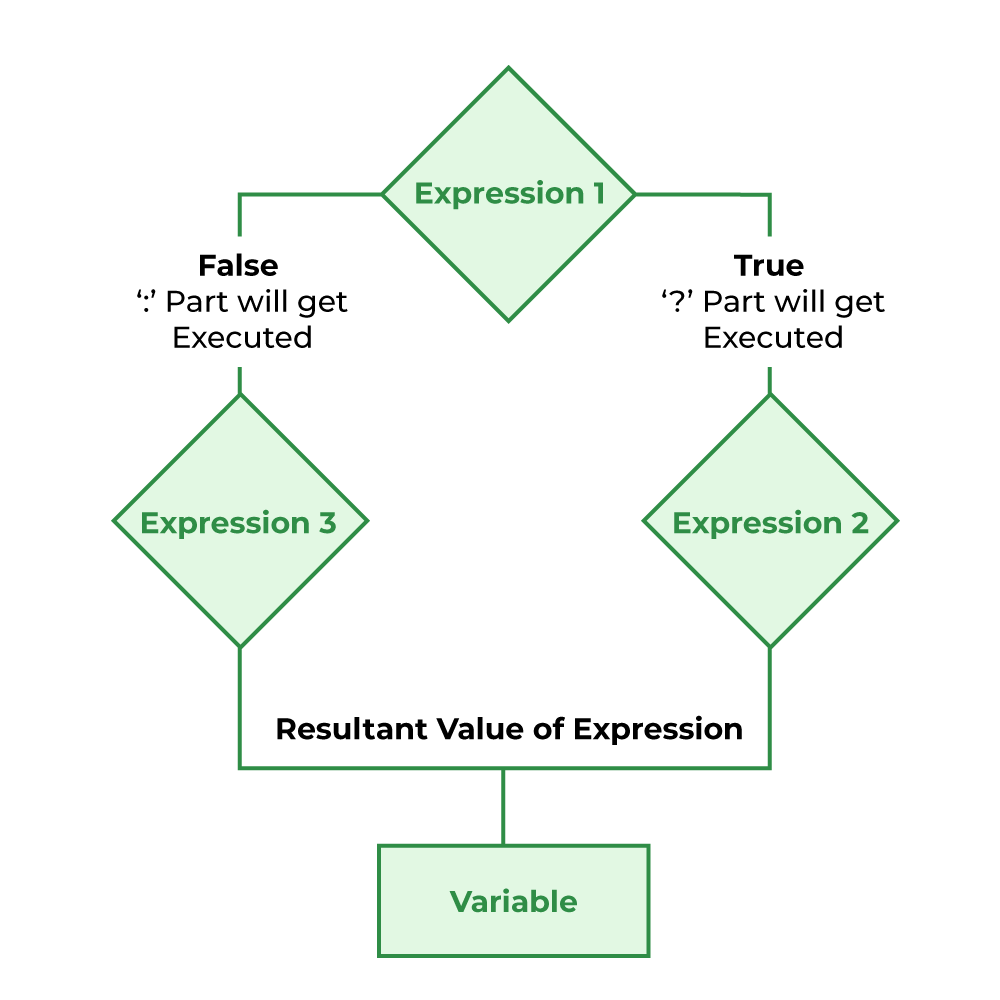
Flow Diagram of Conditional Operator
Example of Conditional Operator
C
// C Program to illustrate the use of conditional operator #include <stdio.h> // driver code int main() { int var; int flag = 0; // using conditional operator to assign the value to var // according to the value of flag var = flag == 0 ? 25 : -25; printf("Value of var when flag is 0: %d\n", var); // changing the value of flag flag = 1; // again assigning the value to var using same statement var = flag == 0 ? 25 : -25; printf("Value of var when flag is NOT 0: %d", var); return 0; }
OutputValue of var when flag is 0: 25 Value of var when flag is NOT 0: -25
7. Jump Statements in C
These statements are used in C for the unconditional flow of control throughout the functions in a program. They support four types of jump statements:
A) break
This loop control statement is used to terminate the loop. As soon as the break statement is encountered from within a loop, the loop iterations stop there, and control returns from the loop immediately to the first statement after the loop.
Syntax of breakbreak;
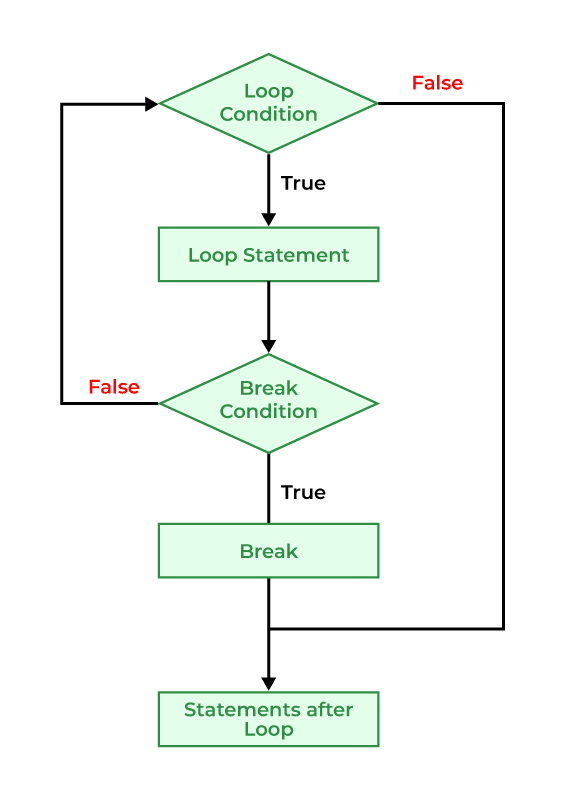
C
// C program to illustrate // to show usage of break // statement #include <stdio.h> void findElement(int arr[], int size, int key) { // loop to traverse array and search for key for (int i = 0; i < size; i++) { if (arr[i] == key) { printf("Element found at position: %d", (i + 1)); break; } } } int main() { int arr[] = { 1, 2, 3, 4, 5, 6 }; // no of elements int n = 6; // key to be searched int key = 3; // Calling function to find the key findElement(arr, n, key); return 0; }
OutputElement found at position: 3
B) continue
This loop control statement is just like the break statement. The continue statement is opposite to that of the break statement, instead of terminating the loop, it forces to execute the next iteration of the loop.
As the name suggests the continue statement forces the loop to continue or execute the next iteration. When the continue statement is executed in the loop, the code inside the loop following the continue statement will be skipped and the next iteration of the loop will begin.
Syntax of continuecontinue;
Flowchart of Continue
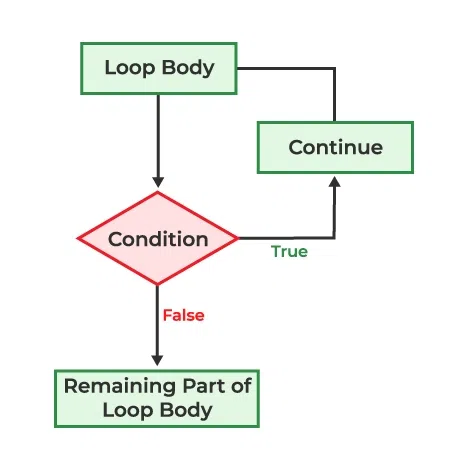
Flow Diagram of C continue Statement
Example of continue
C
// C program to explain the use // of continue statement #include <stdio.h> int main() { // loop from 1 to 10 for (int i = 1; i <= 10; i++) { // If i is equals to 6, // continue to next iteration // without printing if (i == 6) continue; else // otherwise print the value of i printf("%d ", i); } return 0; }
Output1 2 3 4 5 7 8 9 10
If you create a variable in if-else in C, it will be local to that if/else block only. You can use global variables inside the if/else block. If the name of the variable you created in if/else is as same as any global variable then priority will be given to the `local variable`.
C
#include <stdio.h> int main() { int gfg = 0; // local variable for main printf("Before if-else block %d\n", gfg); if (1) { int gfg = 100; // new local variable of if block printf("if block %d\n", gfg); } printf("After if block %d", gfg); return 0; }
OutputBefore if-else block 0 if block 100 After if block 0
C) goto
The goto statement in C also referred to as the unconditional jump statement can be used to jump from one point to another within a function.
Syntax of gotoSyntax1 | Syntax2 ---------------------------- goto label; | label: . | . . | . . | . label: | goto label;
In the above syntax, the first line tells the compiler to go to or jump to the statement marked as a label. Here, a label is a user-defined identifier that indicates the target statement. The statement immediately followed after ‘label:’ is the destination statement. The ‘label:’ can also appear before the ‘goto label;’ statement in the above syntax.
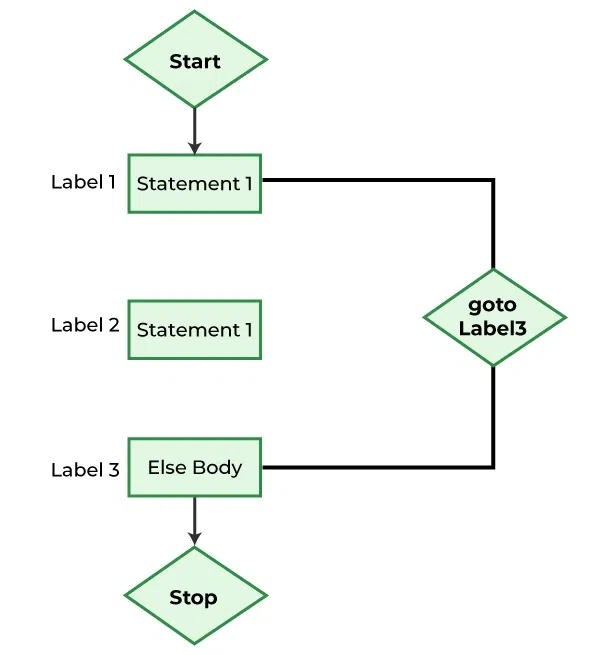
Flowchart of goto Statement
Examples of goto
C
// C program to print numbers // from 1 to 10 using goto // statement #include <stdio.h> // function to print numbers from 1 to 10 void printNumbers() { int n = 1; label: printf("%d ", n); n++; if (n <= 10) goto label; } // Driver program to test above function int main() { printNumbers(); return 0; }
Output1 2 3 4 5 6 7 8 9 10
D) return
The return in C returns the flow of the execution to the function from where it is called. This statement does not mandatorily need any conditional statements. As soon as the statement is executed, the flow of the program stops immediately and returns the control from where it was called. The return statement may or may not return anything for a void function, but for a non-void function, a return value must be returned.
Flowchart of return
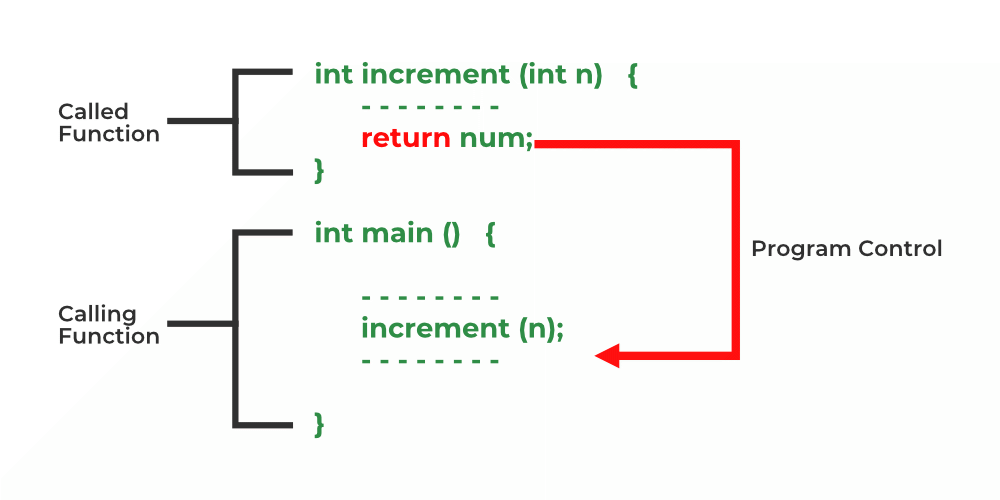
Flow Diagram of return
Syntax of returnreturn [expression];
Example of return
C
// C code to illustrate return // statement #include <stdio.h> // non-void return type // function to calculate sum int SUM(int a, int b) { int s1 = a + b; return s1; } // returns void // function to print void Print(int s2) { printf("The sum is %d", s2); return; } int main() { int num1 = 10; int num2 = 10; int sum_of = SUM(num1, num2); Print(sum_of); return 0; }
OutputThe sum is 20
Types of Operators in C
Types of Operators in C
- Arithmetic Operator
- Increment/Decrement Operator
- Assignment Operator
- Logical Operator
- Bitwise Operator
- Misc Operator
Arithmetic Operators are the operators which are used to perform mathematical calculations like addition (+), subtraction (-), multiplication (*), division (/), and modulus (%). It performs all the operations on numerical values (constants and variables).
Increment/Decrement Operator With Example
C programming has basically two operators which can increment ++ and decrement -- the value of a variable. It can change the value of an operand (constant or variable) by 1. Increment and Decrement Operators are very useful operators that are generally used to minimize the calculation. These two operators are unary operators, which means they can only operate on a single operand. For example, ++x and x++ means x=x+1 or --x and x−− means x=x-1.
There is a slight distinction between ++ or −− when written before or after any operand.
If we use the operator as a pre-fix, it adds 1 to the operand, and the result is assigned to the variable on the left. Whereas, when it is used as a post-fix, it first assigns the value to the variable on the left i.e., it first returns the original value, and then the operand is incremented by 1.
Assignment Operator With Example
An assignment operator is mainly responsible for assigning a value to a variable in a program. Assignment operators are applied to assign the result of an expression to a variable. This operator plays a crucial role in assigning the values to any variable. The most common assignment operator is =.
Relational/Comparison Operator With Example
Relational operators are specifically used to compare two quantities or values in a program. It checks the relationship between two operands. If the given relation is true, it will return 1 and if the relation is false, then it will return 0. Relational operators are heavily used in decision-making and performing loop operations.
The table below shows all the relational operators supported by C. Here, we assume that the variable A holds 15 and the variable B holds the 25.
Operator
== It is used to check if the values of the two operands are equal or not. If the values of the two operands are equal, then the condition becomes true. (A == B) is not true.
!= It is used to check if the values of the two operands are equal or not. If the values are not equal, then the condition becomes true. (A != B) is true.
> It is used to check if the value of left operand is greater than the value of right operand. If the left operand is greater, then the condition becomes true. (A > B) is not true.
< It is used to check if the value of left operand is less than the value of right operand. If the left operand is lesser, then the condition becomes true. (A < B) is true.
>= It is used to check if the value of left operand is greater than or equal to the value of right operand. If the value of the left operand is greater than or equal to the value, then the condition becomes true. (A >= B) is not true.
<= It is used to check if the value of left operand is less than or equal to the value of right operand. If the value of the left operand is less than or equal to the value, then the condition becomes true. (A <= B) is true.
Logical Operator With Example
In the C programming language, we have three logical operators when we need to test more than one condition to make decisions. These logical operators are:
- && (meaning logical AND)
- || (meaning logical OR)
- ! (meaning logical NOT)
An expression containing a logical operator in C language returns either 0 or 1 depending upon the condition whether the expression results in true or false. Logical operators are generally used for decision-making in C programming.
Data Types in C
Data types are the type of data stored in a C program. Data types are used while defining a variable or functions in C. It’s important for the compiler to understand the type of predefined data it is going to encounter in the program. In this article, we will discuss Data type in C programming with example.
How does do while loop works in C ?
do…while Loop in C
The do…while in C is a loop statement used to repeat some part of the code till the given condition is fulfilled. It is a form of an exit-controlled or post-tested loop where the test condition is checked after executing the body of the loop. Due to this, the statements in the do…while loop will always be executed at least once no matter what the condition is.Syntax of do…while Loop in C
// body of do-while loop
} while (condition);
How does the do…while Loop works?
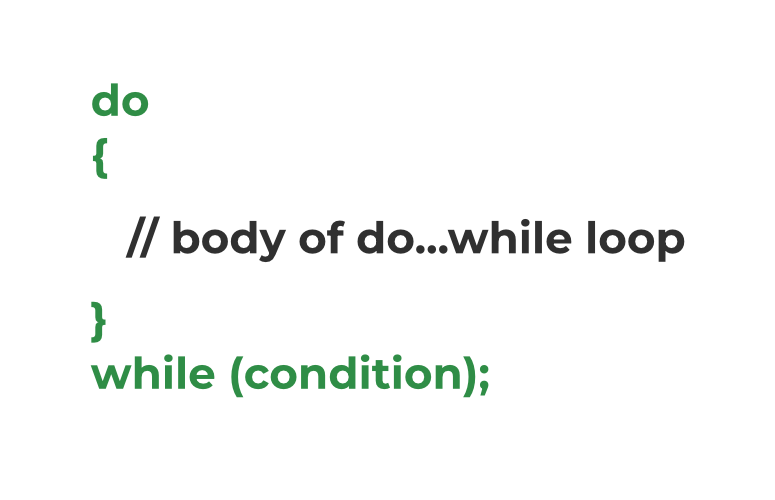
Syntax Structure of do while loop
The working of the do…while loop is explained below:
When the test condition is evaluated as true, the program control goes to the start of the loop and the body is executed once more.
The above process repeats till the test condition is true.
When the test condition is evaluated as false, the program controls move on to the next statements after the do…while loop.
As with the while loop in C, initialization and updation is not a part of the do…while loop syntax. We have to do that explicitly before and in the loop respectively.
How does the "for loop" work in C?
How does the "for loop" work?
The for loop in C first evaluates the initialization expression. If it evaluates true, the first iteration of the loop will run, if false the loop will not run. The code within the loop will executed and then the loop will be updated by the loop expression and re-evaluated. If it is evaluated as true again, the body will run again. If it is false, the loop will exit.
How do computer programmers write a "for loop"?
The basic syntax of a for loop in C is the for statement followed by a number of control expressions separated by semi-colons:
for (A; B; C)
{
body
}
A = initialize expression - the expression that will be used in the first evaluation
B = conditional expression - the expression that will be used to evaluate whether the loop should run again or exit
C = loop expression(increment/decrement) - this updates the variable for each iteration of the loop
The body is the block of code that will run as long as the conditional expression is true.
what is return 0 in c ?
What is the exact use of return 0 in c programming? When does the 0 goes to or returns to ? What is a calling function? Can some one explain me this with using simple language as I am not familiar with programming?
The statement return 0; is used to indicate that a C program has completed successfully and is ready to exit. When you write a C program, the main function typically has the following structure:
- int main() {
- // Your program code goes here
- return 0;
- }
The return 0; statement at the end of the main() function is used to indicate that the program has executed without any errors. The value 0 is then returned to the operating system or the program that called your C program.
Inside the main function:
- return 0: A return 0 means that the program will execute successfully and did what it was intended to do.
- return 1: A return 1 means that there is some error while executing the program, and it is not performing what it was intended to do.
- return 0: returning false from a function.
- return 1: returning true from a function.
Conclusion:
| Use-case | return 0 | return 1 |
| In the main function | return 0 in the main function means that the program executed successfully. | return 1 in the main function means that the program does not execute successfully and there is some error. |
| In user-defined function | return 0 means that the user-defined function is returning false. | return 1 means that the user-defined function is returning true. |
main() function in C
Syntax of C main() Function
Types of C main Functions
void main()
{
// Function body
}int main()
{
// Function body
}int main(int argc, char* argv[])
{
// Function body
}Declare an Array in C
-Declare an Array
-Syntax of an Array
-How to initialize an Array
Arrays
Arrays are used to store multiple values in a single variable, instead of declaring separate variables for each value.
To create an array, define the data type (like int) and specify the name of the array followed by square brackets [].
To insert values to it, use a comma-separated list, inside curly braces:
Integer Data Type Array Declaration and Initialization:
int myNumbers[4] = { 25, 50, 75, 100 };
Float Data Type Array Declaration and Initialization:
char myChar[4] = { 'c', 'h', '$', '*' } ;